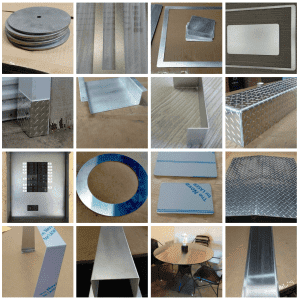Aluminum Channel: All You Need to Know about Aluminum Extrusion?

From structural to architectural industries, metal channels can serve a wide variety of purposes across many organizations. Aluminum channels are the most preferred metal channels in the marketplaces due to their durability and high water resistance levels. It is an extremely versatile metal that can be used for a number of applications including repairs of buildings, vehicles, machinery, electrical appliances, and more. This lightweight and flexible metal channel can be manufactured into a variety of shapes and sizes as per your needs and preferences.
Extruded aluminum channels can be used to construct complex designs and structures for many areas in and around architectural applications. Therefore choosing aluminum channels for your architectural business can be an ideal decision for your business success. For homeowners, installing extruded aluminum channels can help them save a lot of money from unwanted repairs and other maintenance costs. In this guide, we will walk you through some of the most significant information and facts about extruded aluminum channels that will assist you to broaden your knowledge about aluminum channels and help you make wise decisions.
So let us begin this blog by understanding extruded aluminum channels in detail.
What is an Extruded Aluminum Channel?
The process by which aluminum alloy material is forced through a die with a specific cross-section profile is called aluminum extrusion. Extruded aluminum channel is the by-product of heating aluminum material and pushing it through a die. The material is heated at a high temperature of around 900 degrees F and then loaded into an extrusion press. The extrusion press is a powerful ram that pushes the aluminum through the die and it emerges from the die opening.
The aluminum material comes out in a shape like a die which is pulled out along a runout table. The extrusion process allows you to create shapes that are more complex in nature. Along with that extruded aluminum channels can enhance any surface they are applied to and leave everlasting impressions. Extruded aluminum channels are quite easy to maintain, clean, polish, and be a perfect addition to any design project.
Extruded Channels | Use & Application
Now let us look at the list of some common extruded aluminum channel applications and uses.
1. Architecture and Construction
This category of extruded aluminum channel application range from railings and balustrades to building facades and more. Aluminum channels can be an ideal option for applications like canopies where the structure must handle loads without weighing much.
2. Display Equipment
Most types of stands and furniture used in trade shows or exhibitions are constructed with structural aluminum channels. Extruded aluminum channel applications make it easy for structures to move around and assemble quickly.
3. Electrical System
Extruded aluminum applications are generally good conductors and can be used for busbars and related electrical equipment. Extruded applications with fins make an excellent radiator or heat exchanger that can be easily mounted to and colored.
4. Industrial and Transportation
Aluminum channels are the first choice of many organizations across the globe. They are widely used for equipment like workbenches, inspection tables, carts, and more. Due to their lightweight and high durability levels, aluminum channels are the top choices in the transportation industry.
Aluminum Extruded Channels | Custom & OEM
One of the best parts of opting for extruded aluminum channels is that you can easily customize the shape and size of your material. Experts at Metalscut4u offer the best custom and OEM aluminum extrusion services to meet all your needs and requirements. Therefore all you have to do is inform our experts about the size, shape, specifications, and type of aluminum material you would like to have and our experts will make sure to fulfill all your needs.
Common Aluminum Channel Sizes
Aluminum channels are the optimum choice for applications that require high strength and corrosion resistance properties. Here is a list of some of the common aluminum channel sizes available in the market for you to choose from.
- 1/16” wall thickness.
- 3/32” Wall Thickness.
- 1/ 8” Wall thickness.
- 3/16” wall thickness.
- / 4” Wall thickness.
Different Types of Aluminum Channels
Generally, there are 2 aluminum channels that are used widely all over the world. These aluminum channels come in two varieties such as Aluminum Association and American standard aluminum channel. Both these aluminum channels can be extruded from 6000 and 7000 series aluminum. The two most common alloys from these series are the 6061 aluminum channel and the 7075 aluminum channel.
There is a huge variety of aluminum channel options available in the market such as nut channels, slide track channels, Z channels, F aluminum channels, and many more. Here are some most common and different types of aluminum channels to choose from.
1. Aluminum Hat Channel
These channels are named for their unique hat-like appearance. Aluminum hat channels are composed of two horizontal flanges that reach outward and two vertical dimensions. These channels can be designed in a range of sizes that can vary in thickness, height, and weight depending on your needs and requirements. Typically the thickness of these channels can range anywhere between .005” to .150”.
2. Aluminum U Channel & J Channel
These types of channels typically feature additional fabrications following the extrusion process. The inline fabrications that are most commonly used post extrusion during the manufacturing process include holes, notches, tabs, key slots, material insertion, depressions, embossing, and others. Both aluminum U channel and J channel can be used in a wide range of applications across many industries in the marketplaces.
3. Aluminum C Channel
Similar to all other channels, aluminum C channels are available in a variety of lengths and thicknesses. Aluminum C channel thickness can range between .003” to .500” thick. These channels can be used for framing, covers, decorations, railings, trim, posts, and tracks applications.
People Also Ask Questions
- How to cut an aluminum pole?
Answer: You can use a hacksaw to easily cut an aluminum pole into different lengths or shapes. Also if you don’t know how to use a hacksaw you must make sure to consult an expert for the same. - How strong is the aluminum box section?
Answer: Due to its unique set of qualities, aluminum box-section is often the preferred choice of material over steel by many organizations in the market. It is quite strong material compared to other metals in the market. - How thick is 0.25 aluminum?
Answer: The thickness of 0.25 aluminum has 1/40”. It can vary depending on your need and preferences. - How to cut aluminum bar stock?
Answer: You can use a chop saw blade or miter gauge to cut the aluminum channel bar stocks into different shapes and sizes. There are various types of cutting saws available in the market, you choose the one that suits your needs the best. - How to cut an aluminum flat bar?
Answer: A wood-cutting saw with carbide-tipped blades is an optimum cutting tool available in the market to cut the aluminum channel flat bar into various pieces. - What is the cost of an aluminum sheet?
Answer: Depending on your aluminum channel specification and requirements the cost of the aluminum sheet can vary from customer to customer. Complex designs with high specifications and arrangements can cost you more compared to simple aluminum sheets on the market.
We hope with this blog, you now have a better understanding of aluminum channels. If you wish to learn more about metric aluminum channels or know more about aluminum channel weight per foot then you can contact our experts today.
